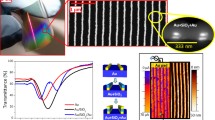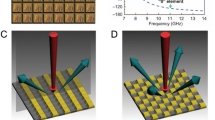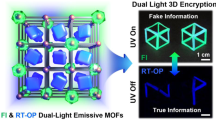Abstract
Plasmonic encoding composed of metallic nanostructures makes a great contribution to the practical application of information encryption. However, most reports have so far shown the preparation of single or binary plasmonic encoding patterns because of the technical difficulty of assembling multiplex nanostructures on a single platform, which cannot satisfy the requirements of high encoding capacity for increasing information security. Herein, we developed a strategy based on plasma etching combined with in-situ growth to fabricate patterned arrays of quasi-three-dimensional (3-D) plasmonic Au nano-mushrooms with controlled morphologies, and successfully realized ideal high-capacity plasmonic encoding by arranging Au nano-mushrooms on one platform. On this basis, such multiplex encoding patterns have been transferred to the flexible substrate to realize the triple-mode encryption of the Morse code of “FUNSOM”, indicating great prospects in the applications of information encryption and data storage.

摘要
由金属纳米结构组成的等离激元编码在信息加密的实际应用中做出了巨大贡献. 然而, 由于在单一平台上排列集成水平较高的多元纳米结构的技术难度较大, 目前大多数报道只展示了单一或二元等离激元编码的制备, 这无法满足日益提高的信息安全性对于高编码容量的要求. 在此, 我们开发了一种基于等离子体刻蚀-生长的策略, 制备了具有可控形态的准三维等离激元金纳米蘑菇的图案阵列, 并通过将这些纳米蘑菇排列在一个基底上, 成功实现了理想的高容量等离激元编码. 在此基础上, 将这种多元编码转移到柔性基板上, 实现了对代表“FUNSOM”的摩斯密码的三模态加密, 展示了开发的等离激元编码在信息加密和数据存储等领域的广阔应用前景.
Similar content being viewed by others
References
Fang X, Ren H, Gu M. Orbital angular momentum holography for high-security encryption. Nat Photonics, 2019, 14: 102–108
Meng F, Umair MM, Zhang S, et al. Facile fabrication of encryption composite materials with trilayer quasi-amorphous heterostructure. Sci China Mater, 2020, 64: 909–919
Crossler RE, Johnston AC, Lowry PB, et al. Future directions for behavioral information security research. Comput Security, 2013, 32: 90–101
Gu L, Wu H, Ma H, et al. Color-tunable ultralong organic room temperature phosphorescence from a multicomponent copolymer. Nat Commun, 2020, 11: 944
Luo X, Hu Y, Li X, et al. Integrated metasurfaces with microprints and helicity-multiplexed holograms for real-time optical encryption. Adv Opt Mater, 2020, 8: 1902020
Wang Y, Shang L, Bian F, et al. Hollow colloid assembled photonic crystal clusters as suspension barcodes for multiplex bioassays. Small, 2019, 15: 1900056
Liu X, Chen ZH, Zhang H, et al. Independent luminescent lifetime and intensity tuning of upconversion nanoparticles by gradient doping for multiplexed encoding. Angew Chem Int Ed, 2021, 60: 7041–7045
Bruns OT, Bischof TS, Harris DK, et al. Next-generation in vivo optical imaging with short-wave infrared quantum dots. Nat Biomed Eng, 2017, 1: 0056
Pekdemir S, Torun I, Sakir M, et al. Chemical funneling of colloidal gold nanoparticles on printed arrays of end-grafted polymers for plasmonic applications. ACS Nano, 2020, 14: 8276–8286
Wang Y, Li D, Sun Y, et al. Multiplexed assembly of plasmonic nanostructures through charge inversion on substrate for surface encoding. ACS Appl Mater Interfaces, 2020, 12: 6176–6182
Li D, Sun YH, Wang ZS, et al. Large-scale multiplexed surface plasmonic gold nanostructures based on nanoimprint and self-assembly. Chem J Chin Univ, 2020, 41: 221–227
Zhong Y, Ma S, Chen K, et al. Controlled growth of plasmonic heterostructures and their applications. Sci China Mater, 2020, 63: 1398–1417
Jiang R, Li B, Fang C, et al. Metal/semiconductor hybrid nanostructures for plasmon-enhanced applications. Adv Mater, 2014, 26: 5274–5309
Feng R, Wang H, Cao Y, et al. A modular design of continuously tunable full color plasmonic pixels with broken rotational symmetry. Adv Funct Mater, 2022, 32: 2108437
Xue J, Zhou ZK, Lin L, et al. Perturbative countersurveillance metaoptics with compound nanosieves. Light Sci Appl, 2019, 8: 101
Gu Y, He C, Liu F, et al. Raman ink for steganography. Adv Opt Mater, 2021, 9: 2002038
Sun J, Li Z, Sun Y, et al. Uniform and reproducible plasmon-enhanced fluorescence substrate based on PMMA-coated, large-area Au@Ag nanorod arrays. Nano Res, 2017, 11: 953–965
Wang W. Imaging the chemical activity of single nanoparticles with optical microscopy. Chem Soc Rev, 2018, 47: 2485–2508
Zheng Y, Jiang C, Ng SH, et al. Unclonable plasmonic security labels achieved by shadow-mask-lithography-assisted self-assembly. Adv Mater, 2016, 28: 2330–2336
Fothergill SM, Joyce C, Xie F. Metal enhanced fluorescence biosensing: From ultra-violet towards second near-infrared window. Nanoscale, 2018, 10: 20914–20929
Yang F, Ye S, Dong W, et al. Laser-scanning-guided assembly of quasi-3D patterned arrays of plasmonic dimers for information encryption. Adv Mater, 2021, 33: 2100325
Ibrar M, Skrabalak SE. Designer plasmonic nanostructures for unclonable anticounterfeit tags. Small Struct, 2021, 2: 2100043
Kundu PK, Samanta D, Leizrowice R, et al. Light-controlled self-assembly of non-photoresponsive nanoparticles. Nat Chem, 2015, 7: 646–652
Si KJ, Sikdar D, Yap LW, et al. Dual-coded plasmene nanosheets as next-generation anticounterfeit security labels. Adv Opt Mater, 2015, 3: 1710–1717
Bai B, Xu M, Li J, et al. Dopant diffusion equilibrium overcoming impurity loss of doped QDs for multimode anti-counterfeiting and encryption. Adv Funct Mater, 2021, 31: 2100286
Scarabelli L. Recent advances in the rational synthesis and self-assembly of anisotropic plasmonic nanoparticles. Pure Appl Chem, 2018, 90: 1393–1407
Chen J, Sun Y, Zhong L, et al. Scalable fabrication of multiplexed plasmonic nanoparticle structures based on AFM lithography. Small, 2016, 12: 5818–5825
Liu Y, Lee YH, Zhang Q, et al. Plasmonic nanopillar arrays encoded with multiplex molecular information for anti-counterfeiting applications. J Mater Chem C, 2016, 4: 4312–4319
Ruan Q, Shao L, Shu Y, et al. Growth of monodisperse gold nanospheres with diameters from 20 nm to 220 nm and their core/satellite nanostructures. Adv Opt Mater, 2014, 2: 65–73
Lee YJ, Schade NB, Sun L, et al. Ultrasmooth, highly spherical monocrystalline gold particles for precision plasmonics. ACS Nano, 2013, 7: 11064–11070
Zheng Y, Zhong X, Li Z, et al. Successive, seed-mediated growth for the synthesis of single-crystal gold nanospheres with uniform diameters controlled in the range of 5–150 nm. Part Part Syst Charact, 2014, 31: 266–273
Yang P, Zheng J, Xu Y, et al. Colloidal synthesis and applications of plasmonic metal nanoparticles. Adv Mater, 2016, 28: 10508–10517
Jiang L, Chen X, Lu N, et al. Spatially confined assembly of nanoparticles. Acc Chem Res, 2014, 47: 3009–3017
Liang W, Li D, Sun Y, et al. Growing in-plane multiplex plasmonic arrays for synergistic enhanced photocurrent response. Adv Mater Interfaces, 2019, 7: 1900966
Müller MB, Kuttner C, König TAF, et al. Plasmonic library based on substrate-supported gradiential plasmonic arrays. ACS Nano, 2014, 8: 9410–9421
Lin L, Xue J, Xu H, et al. Integrating lattice and gap plasmonic modes to construct dual-mode metasurfaces for enhancing light-matter interaction. Sci China Mater, 2021, 64: 3007–3016
James TD, Mulvaney P, Roberts A. The plasmonic pixel: Large area, wide gamut color reproduction using aluminum nanostructures. Nano Lett, 2016, 16: 3817–3823
Yue W, Gao S, Lee SS, et al. Highly reflective subtractive color filters capitalizing on a silicon metasurface integrated with nanostructured aluminum mirrors. Laser Photonics Rev, 2017, 11: 1600285
Lei DY, Fernández-Domínguez AI, Sonnefraud Y, et al. Revealing plasmonic gap modes in particle-on-film systems using dark-field spectroscopy. ACS Nano, 2012, 6: 1380–1386
Li GC, Zhang YL, Jiang J, et al. Metal-substrate-mediated plasmon hybridization in a nanoparticle dimer for photoluminescence line-width shrinking and intensity enhancement. ACS Nano, 2017, 11: 3067–3080
Li GC, Zhang Q, Maier SA, et al. Plasmonic particle-on-film nanocavities: A versatile platform for plasmon-enhanced spectroscopy and photochemistry. Nanophotonics, 2018, 7: 1865–1889
Liu J, Lo TW, Qiu M, et al. Brightening of dark excitons in monolayer WS2 sandwiched in a metal-film-coupled nanocavity. In: 2018 Conference on Lasers and Electro-Optics Pacific Rim, CLEO-PR 2018. Hong Kong, 2018
Li J, Chen K, Wei J, et al. Reversible on-off switching of excitation-wavelength-dependent emission of a phosphorescent soft salt based on platinum(II) complexes. J Am Chem Soc, 2021, 143: 18317–18324
Kamali SM, Arbabi A, Arbabi E, et al. Decoupling optical function and geometrical form using conformal flexible dielectric metasurfaces. Nat Commun, 2016, 7: 11618
Ee HS, Agarwal R. Tunable metasurface and flat optical zoom lens on a stretchable substrate. Nano Lett, 2016, 16: 2818–2823
Liang C, Luan J, Wang Z, et al. Gold nanorod size-dependent fluorescence enhancement for ultrasensitive fluoroimmunoassays. ACS Appl Mater Interfaces, 2021, 13: 11414–11423
Acknowledgements
This work was supported by the National Natural Science Foundation of China (21822202, 22072104), the National Key R&D Program of China (International Collaboration program) granted by Chinese Ministry of Science and Technology (2018YFE0200700). This is also a project funded by Suzhou Key Laboratory of Functional Nano & Soft Materials, Collaborative Innovation Center of Suzhou Nano Science & Technology, the 111 Project, Joint International Research Laboratory of Carbon-Based Functional Materials and Devices.
Author information
Authors and Affiliations
Contributions
Author contributions Li D and Jiang L designed and engineered the samples; Li D, Liang W, Liu Y, Gao H, Ye Y and Li J performed the experiments; Zhao B provided the schematics; Li D wrote the paper with support from Sun Y, Wang Y, and Jiang L. All authors contributed to the general discussion.
Corresponding author
Ethics declarations
Conflict of interest The authors declare that they have no conflict of interest.
Additional information
Supplementary information Experimental details and supporting data are available in the online version of the paper.
Dong Li is currently a doctor candidate under the supervision of Prof. Lin Jiang at Soochow University. His current research interests focus on the preparation and application of plasmonic nanostructures.
Yinghui Sun is currently a professor at Soochow University. He earned his PhD degree in organic chemistry from Jilin University, and completed postdoctoral research at Muenster University and Nanyang Technological University. His research focuses on the development of advanced functional nanomaterials for energy conversion.
Yawen Wang is currently a laboratory technician in Prof. Lin Jiang’s group. Her research interests include the synthesis, fabrication, and application of plasmonic metal nanostructures.
Lin Jiang is currently a professor at Soochow University. She received her doctorate from Jilin University in 2005, and became a professor at Soochow University in 2012. Her research interests include controllable assembly, property regulation, and application exploration of functional nanomaterials.
Supplementary Information
Rights and permissions
About this article
Cite this article
Li, D., Sun, Y., Wang, Y. et al. Quasi-3-D Au mushrooms with programmable morphology for high-capacity flexible plasmonic encoding. Sci. China Mater. 65, 2227–2234 (2022). https://doi.org/10.1007/s40843-022-2090-1
Received:
Accepted:
Published:
Issue Date:
DOI: https://doi.org/10.1007/s40843-022-2090-1




